A Project Proposal for Severely Disabled People in Nsw Assignment 2022
VerifiedAdded on 2022/10/11
|14
|3702
|10
Assignment
AI Summary
Contribute Materials
Your contribution can guide someone’s learning journey. Share your
documents today.
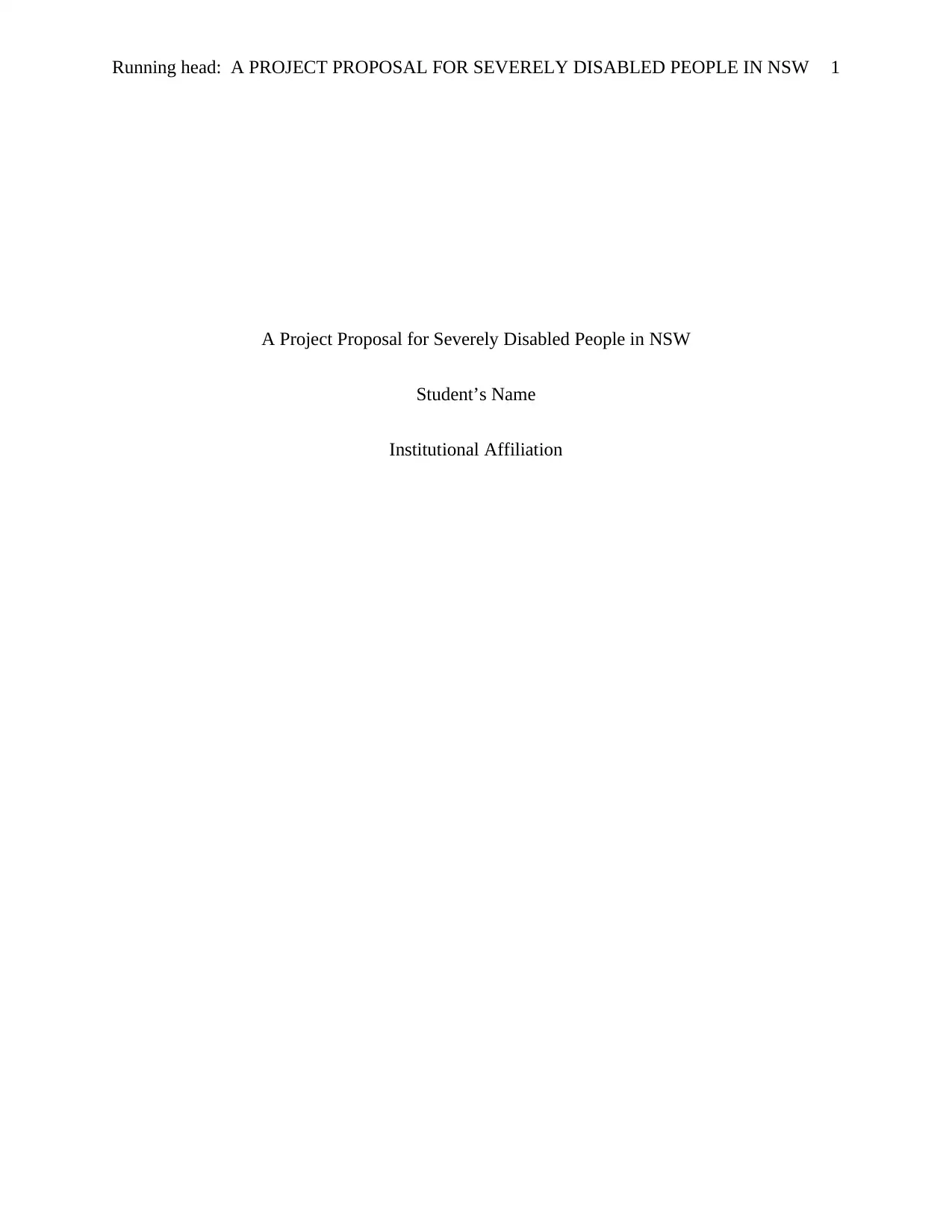
Running head: A PROJECT PROPOSAL FOR SEVERELY DISABLED PEOPLE IN NSW 1
A Project Proposal for Severely Disabled People in NSW
Student’s Name
Institutional Affiliation
A Project Proposal for Severely Disabled People in NSW
Student’s Name
Institutional Affiliation
Secure Best Marks with AI Grader
Need help grading? Try our AI Grader for instant feedback on your assignments.
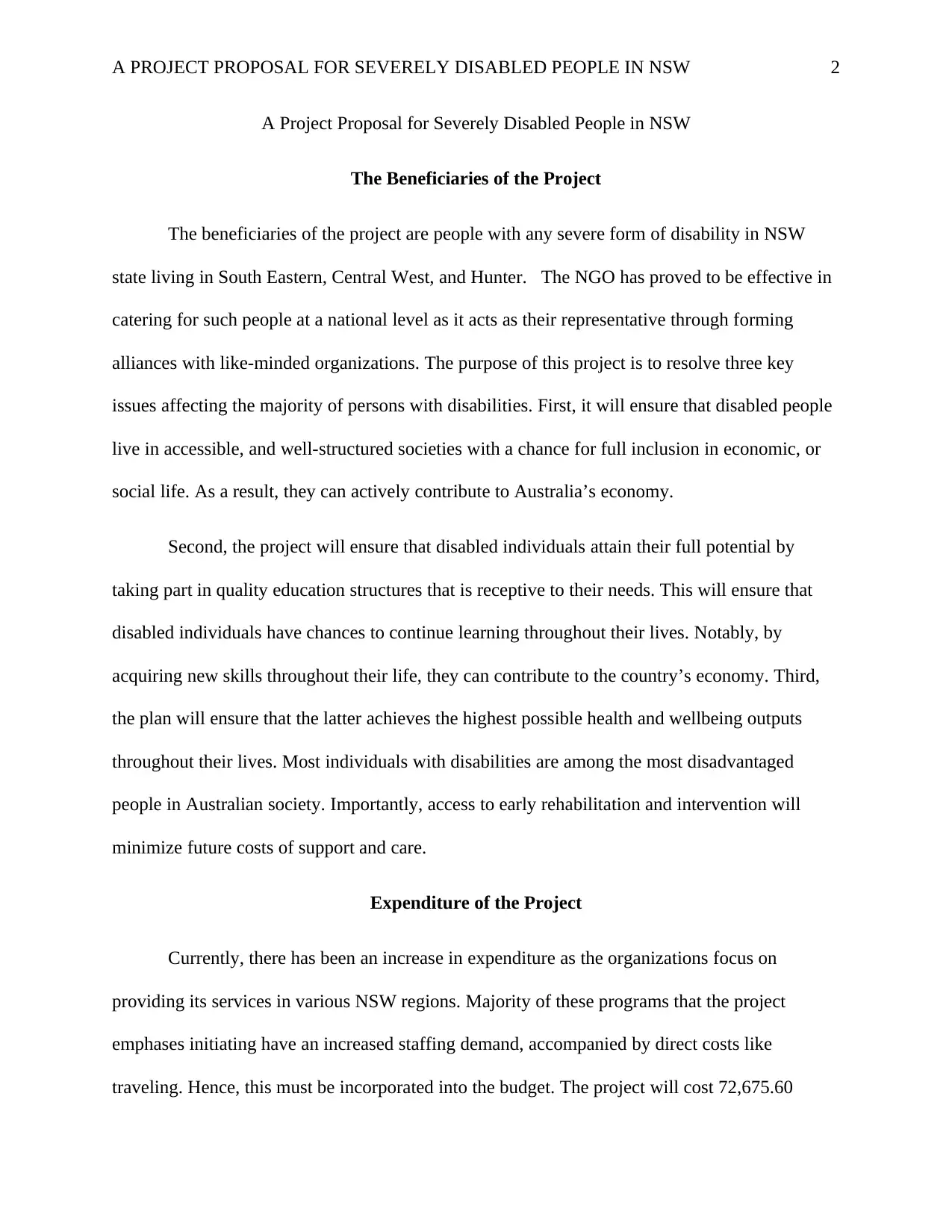
A PROJECT PROPOSAL FOR SEVERELY DISABLED PEOPLE IN NSW 2
A Project Proposal for Severely Disabled People in NSW
The Beneficiaries of the Project
The beneficiaries of the project are people with any severe form of disability in NSW
state living in South Eastern, Central West, and Hunter. The NGO has proved to be effective in
catering for such people at a national level as it acts as their representative through forming
alliances with like-minded organizations. The purpose of this project is to resolve three key
issues affecting the majority of persons with disabilities. First, it will ensure that disabled people
live in accessible, and well-structured societies with a chance for full inclusion in economic, or
social life. As a result, they can actively contribute to Australia’s economy.
Second, the project will ensure that disabled individuals attain their full potential by
taking part in quality education structures that is receptive to their needs. This will ensure that
disabled individuals have chances to continue learning throughout their lives. Notably, by
acquiring new skills throughout their life, they can contribute to the country’s economy. Third,
the plan will ensure that the latter achieves the highest possible health and wellbeing outputs
throughout their lives. Most individuals with disabilities are among the most disadvantaged
people in Australian society. Importantly, access to early rehabilitation and intervention will
minimize future costs of support and care.
Expenditure of the Project
Currently, there has been an increase in expenditure as the organizations focus on
providing its services in various NSW regions. Majority of these programs that the project
emphases initiating have an increased staffing demand, accompanied by direct costs like
traveling. Hence, this must be incorporated into the budget. The project will cost 72,675.60
A Project Proposal for Severely Disabled People in NSW
The Beneficiaries of the Project
The beneficiaries of the project are people with any severe form of disability in NSW
state living in South Eastern, Central West, and Hunter. The NGO has proved to be effective in
catering for such people at a national level as it acts as their representative through forming
alliances with like-minded organizations. The purpose of this project is to resolve three key
issues affecting the majority of persons with disabilities. First, it will ensure that disabled people
live in accessible, and well-structured societies with a chance for full inclusion in economic, or
social life. As a result, they can actively contribute to Australia’s economy.
Second, the project will ensure that disabled individuals attain their full potential by
taking part in quality education structures that is receptive to their needs. This will ensure that
disabled individuals have chances to continue learning throughout their lives. Notably, by
acquiring new skills throughout their life, they can contribute to the country’s economy. Third,
the plan will ensure that the latter achieves the highest possible health and wellbeing outputs
throughout their lives. Most individuals with disabilities are among the most disadvantaged
people in Australian society. Importantly, access to early rehabilitation and intervention will
minimize future costs of support and care.
Expenditure of the Project
Currently, there has been an increase in expenditure as the organizations focus on
providing its services in various NSW regions. Majority of these programs that the project
emphases initiating have an increased staffing demand, accompanied by direct costs like
traveling. Hence, this must be incorporated into the budget. The project will cost 72,675.60
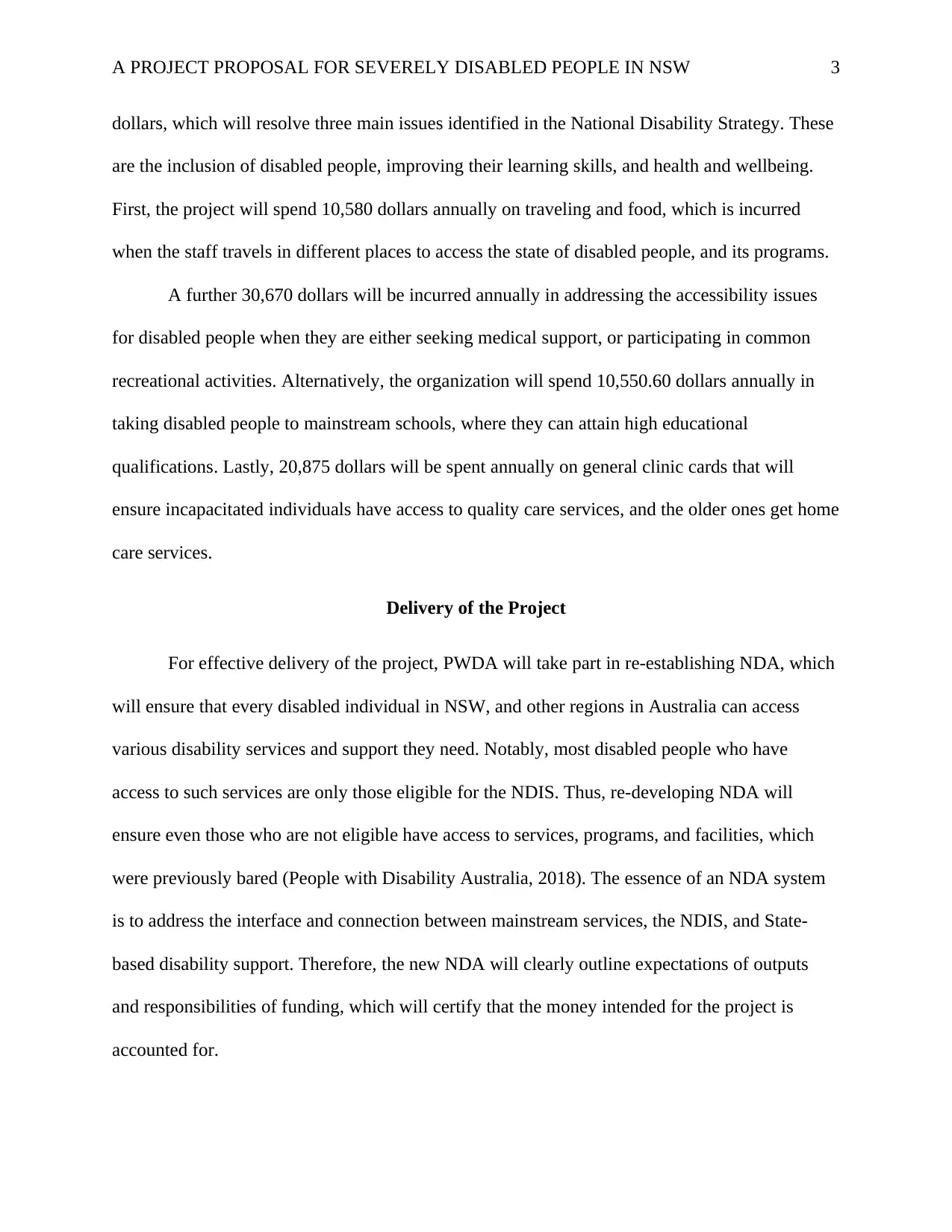
A PROJECT PROPOSAL FOR SEVERELY DISABLED PEOPLE IN NSW 3
dollars, which will resolve three main issues identified in the National Disability Strategy. These
are the inclusion of disabled people, improving their learning skills, and health and wellbeing.
First, the project will spend 10,580 dollars annually on traveling and food, which is incurred
when the staff travels in different places to access the state of disabled people, and its programs.
A further 30,670 dollars will be incurred annually in addressing the accessibility issues
for disabled people when they are either seeking medical support, or participating in common
recreational activities. Alternatively, the organization will spend 10,550.60 dollars annually in
taking disabled people to mainstream schools, where they can attain high educational
qualifications. Lastly, 20,875 dollars will be spent annually on general clinic cards that will
ensure incapacitated individuals have access to quality care services, and the older ones get home
care services.
Delivery of the Project
For effective delivery of the project, PWDA will take part in re-establishing NDA, which
will ensure that every disabled individual in NSW, and other regions in Australia can access
various disability services and support they need. Notably, most disabled people who have
access to such services are only those eligible for the NDIS. Thus, re-developing NDA will
ensure even those who are not eligible have access to services, programs, and facilities, which
were previously bared (People with Disability Australia, 2018). The essence of an NDA system
is to address the interface and connection between mainstream services, the NDIS, and State-
based disability support. Therefore, the new NDA will clearly outline expectations of outputs
and responsibilities of funding, which will certify that the money intended for the project is
accounted for.
dollars, which will resolve three main issues identified in the National Disability Strategy. These
are the inclusion of disabled people, improving their learning skills, and health and wellbeing.
First, the project will spend 10,580 dollars annually on traveling and food, which is incurred
when the staff travels in different places to access the state of disabled people, and its programs.
A further 30,670 dollars will be incurred annually in addressing the accessibility issues
for disabled people when they are either seeking medical support, or participating in common
recreational activities. Alternatively, the organization will spend 10,550.60 dollars annually in
taking disabled people to mainstream schools, where they can attain high educational
qualifications. Lastly, 20,875 dollars will be spent annually on general clinic cards that will
ensure incapacitated individuals have access to quality care services, and the older ones get home
care services.
Delivery of the Project
For effective delivery of the project, PWDA will take part in re-establishing NDA, which
will ensure that every disabled individual in NSW, and other regions in Australia can access
various disability services and support they need. Notably, most disabled people who have
access to such services are only those eligible for the NDIS. Thus, re-developing NDA will
ensure even those who are not eligible have access to services, programs, and facilities, which
were previously bared (People with Disability Australia, 2018). The essence of an NDA system
is to address the interface and connection between mainstream services, the NDIS, and State-
based disability support. Therefore, the new NDA will clearly outline expectations of outputs
and responsibilities of funding, which will certify that the money intended for the project is
accounted for.
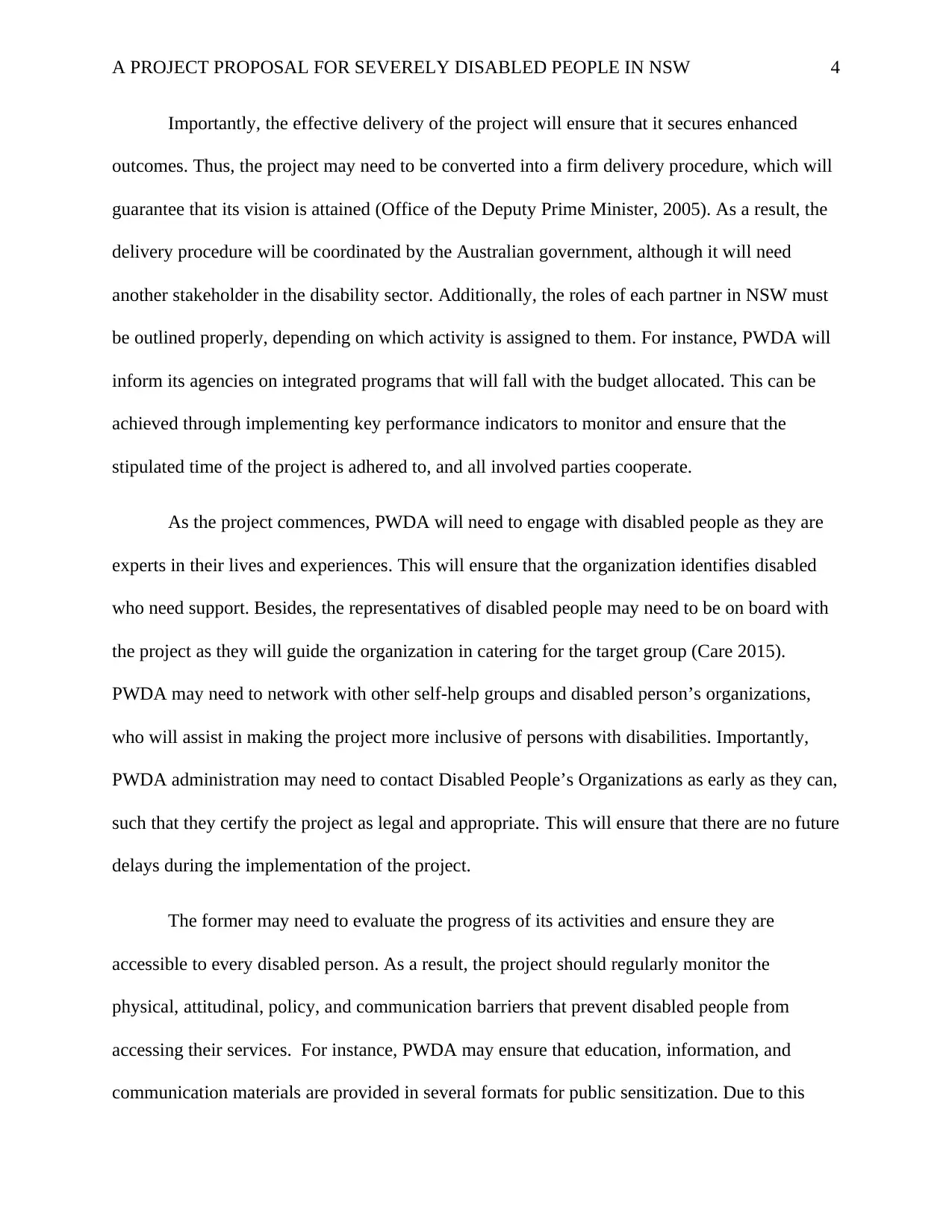
A PROJECT PROPOSAL FOR SEVERELY DISABLED PEOPLE IN NSW 4
Importantly, the effective delivery of the project will ensure that it secures enhanced
outcomes. Thus, the project may need to be converted into a firm delivery procedure, which will
guarantee that its vision is attained (Office of the Deputy Prime Minister, 2005). As a result, the
delivery procedure will be coordinated by the Australian government, although it will need
another stakeholder in the disability sector. Additionally, the roles of each partner in NSW must
be outlined properly, depending on which activity is assigned to them. For instance, PWDA will
inform its agencies on integrated programs that will fall with the budget allocated. This can be
achieved through implementing key performance indicators to monitor and ensure that the
stipulated time of the project is adhered to, and all involved parties cooperate.
As the project commences, PWDA will need to engage with disabled people as they are
experts in their lives and experiences. This will ensure that the organization identifies disabled
who need support. Besides, the representatives of disabled people may need to be on board with
the project as they will guide the organization in catering for the target group (Care 2015).
PWDA may need to network with other self-help groups and disabled person’s organizations,
who will assist in making the project more inclusive of persons with disabilities. Importantly,
PWDA administration may need to contact Disabled People’s Organizations as early as they can,
such that they certify the project as legal and appropriate. This will ensure that there are no future
delays during the implementation of the project.
The former may need to evaluate the progress of its activities and ensure they are
accessible to every disabled person. As a result, the project should regularly monitor the
physical, attitudinal, policy, and communication barriers that prevent disabled people from
accessing their services. For instance, PWDA may ensure that education, information, and
communication materials are provided in several formats for public sensitization. Due to this
Importantly, the effective delivery of the project will ensure that it secures enhanced
outcomes. Thus, the project may need to be converted into a firm delivery procedure, which will
guarantee that its vision is attained (Office of the Deputy Prime Minister, 2005). As a result, the
delivery procedure will be coordinated by the Australian government, although it will need
another stakeholder in the disability sector. Additionally, the roles of each partner in NSW must
be outlined properly, depending on which activity is assigned to them. For instance, PWDA will
inform its agencies on integrated programs that will fall with the budget allocated. This can be
achieved through implementing key performance indicators to monitor and ensure that the
stipulated time of the project is adhered to, and all involved parties cooperate.
As the project commences, PWDA will need to engage with disabled people as they are
experts in their lives and experiences. This will ensure that the organization identifies disabled
who need support. Besides, the representatives of disabled people may need to be on board with
the project as they will guide the organization in catering for the target group (Care 2015).
PWDA may need to network with other self-help groups and disabled person’s organizations,
who will assist in making the project more inclusive of persons with disabilities. Importantly,
PWDA administration may need to contact Disabled People’s Organizations as early as they can,
such that they certify the project as legal and appropriate. This will ensure that there are no future
delays during the implementation of the project.
The former may need to evaluate the progress of its activities and ensure they are
accessible to every disabled person. As a result, the project should regularly monitor the
physical, attitudinal, policy, and communication barriers that prevent disabled people from
accessing their services. For instance, PWDA may ensure that education, information, and
communication materials are provided in several formats for public sensitization. Due to this
Secure Best Marks with AI Grader
Need help grading? Try our AI Grader for instant feedback on your assignments.
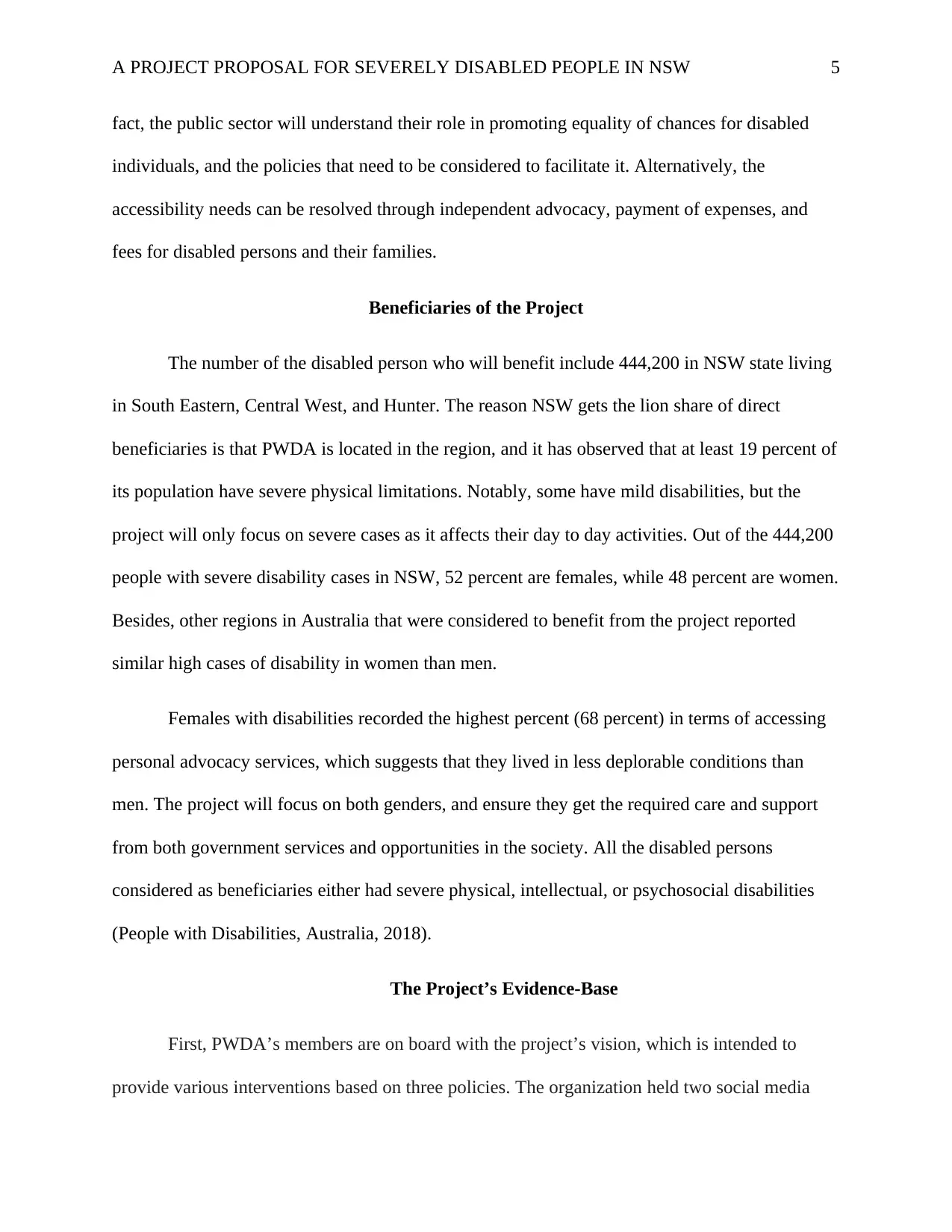
A PROJECT PROPOSAL FOR SEVERELY DISABLED PEOPLE IN NSW 5
fact, the public sector will understand their role in promoting equality of chances for disabled
individuals, and the policies that need to be considered to facilitate it. Alternatively, the
accessibility needs can be resolved through independent advocacy, payment of expenses, and
fees for disabled persons and their families.
Beneficiaries of the Project
The number of the disabled person who will benefit include 444,200 in NSW state living
in South Eastern, Central West, and Hunter. The reason NSW gets the lion share of direct
beneficiaries is that PWDA is located in the region, and it has observed that at least 19 percent of
its population have severe physical limitations. Notably, some have mild disabilities, but the
project will only focus on severe cases as it affects their day to day activities. Out of the 444,200
people with severe disability cases in NSW, 52 percent are females, while 48 percent are women.
Besides, other regions in Australia that were considered to benefit from the project reported
similar high cases of disability in women than men.
Females with disabilities recorded the highest percent (68 percent) in terms of accessing
personal advocacy services, which suggests that they lived in less deplorable conditions than
men. The project will focus on both genders, and ensure they get the required care and support
from both government services and opportunities in the society. All the disabled persons
considered as beneficiaries either had severe physical, intellectual, or psychosocial disabilities
(People with Disabilities, Australia, 2018).
The Project’s Evidence-Base
First, PWDA’s members are on board with the project’s vision, which is intended to
provide various interventions based on three policies. The organization held two social media
fact, the public sector will understand their role in promoting equality of chances for disabled
individuals, and the policies that need to be considered to facilitate it. Alternatively, the
accessibility needs can be resolved through independent advocacy, payment of expenses, and
fees for disabled persons and their families.
Beneficiaries of the Project
The number of the disabled person who will benefit include 444,200 in NSW state living
in South Eastern, Central West, and Hunter. The reason NSW gets the lion share of direct
beneficiaries is that PWDA is located in the region, and it has observed that at least 19 percent of
its population have severe physical limitations. Notably, some have mild disabilities, but the
project will only focus on severe cases as it affects their day to day activities. Out of the 444,200
people with severe disability cases in NSW, 52 percent are females, while 48 percent are women.
Besides, other regions in Australia that were considered to benefit from the project reported
similar high cases of disability in women than men.
Females with disabilities recorded the highest percent (68 percent) in terms of accessing
personal advocacy services, which suggests that they lived in less deplorable conditions than
men. The project will focus on both genders, and ensure they get the required care and support
from both government services and opportunities in the society. All the disabled persons
considered as beneficiaries either had severe physical, intellectual, or psychosocial disabilities
(People with Disabilities, Australia, 2018).
The Project’s Evidence-Base
First, PWDA’s members are on board with the project’s vision, which is intended to
provide various interventions based on three policies. The organization held two social media
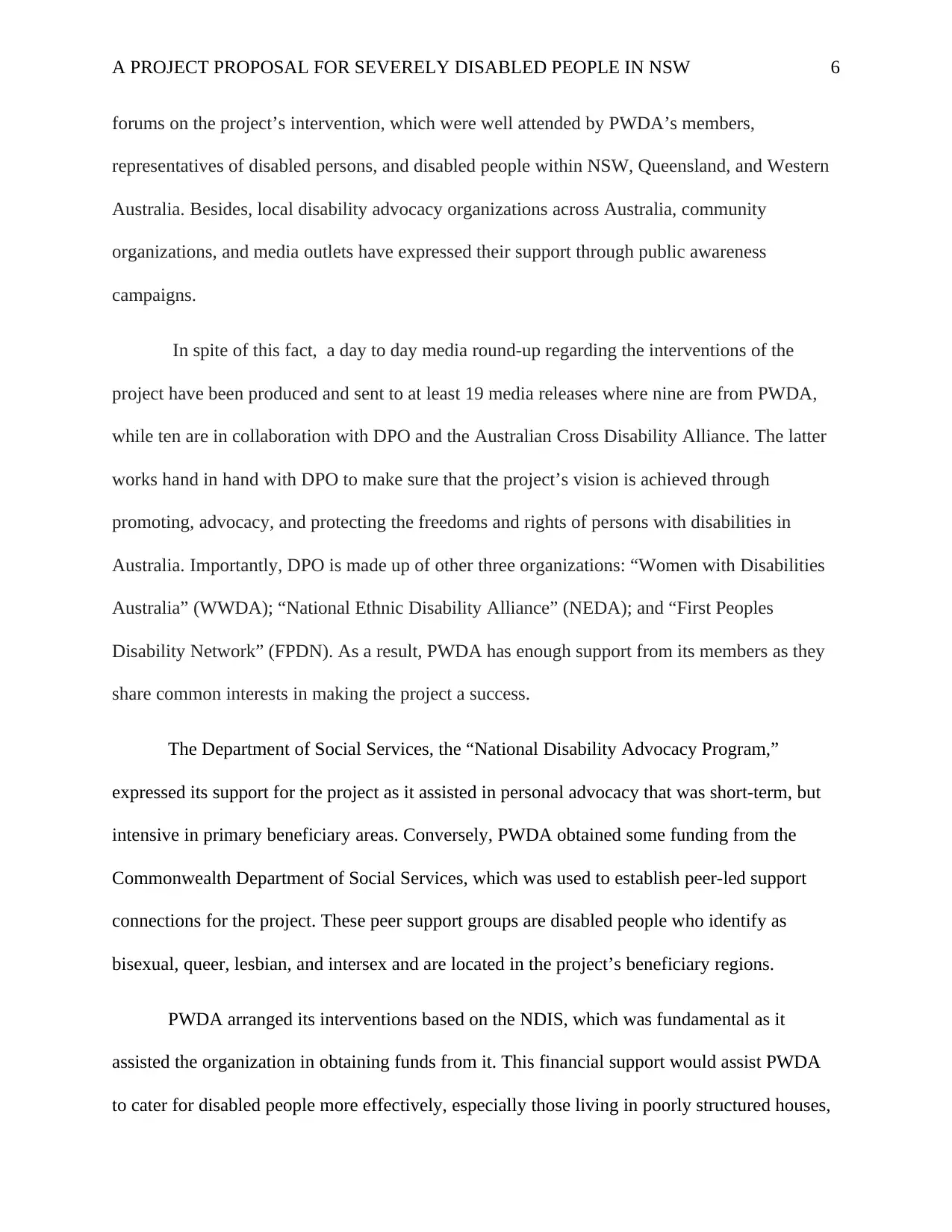
A PROJECT PROPOSAL FOR SEVERELY DISABLED PEOPLE IN NSW 6
forums on the project’s intervention, which were well attended by PWDA’s members,
representatives of disabled persons, and disabled people within NSW, Queensland, and Western
Australia. Besides, local disability advocacy organizations across Australia, community
organizations, and media outlets have expressed their support through public awareness
campaigns.
In spite of this fact, a day to day media round-up regarding the interventions of the
project have been produced and sent to at least 19 media releases where nine are from PWDA,
while ten are in collaboration with DPO and the Australian Cross Disability Alliance. The latter
works hand in hand with DPO to make sure that the project’s vision is achieved through
promoting, advocacy, and protecting the freedoms and rights of persons with disabilities in
Australia. Importantly, DPO is made up of other three organizations: “Women with Disabilities
Australia” (WWDA); “National Ethnic Disability Alliance” (NEDA); and “First Peoples
Disability Network” (FPDN). As a result, PWDA has enough support from its members as they
share common interests in making the project a success.
The Department of Social Services, the “National Disability Advocacy Program,”
expressed its support for the project as it assisted in personal advocacy that was short-term, but
intensive in primary beneficiary areas. Conversely, PWDA obtained some funding from the
Commonwealth Department of Social Services, which was used to establish peer-led support
connections for the project. These peer support groups are disabled people who identify as
bisexual, queer, lesbian, and intersex and are located in the project’s beneficiary regions.
PWDA arranged its interventions based on the NDIS, which was fundamental as it
assisted the organization in obtaining funds from it. This financial support would assist PWDA
to cater for disabled people more effectively, especially those living in poorly structured houses,
forums on the project’s intervention, which were well attended by PWDA’s members,
representatives of disabled persons, and disabled people within NSW, Queensland, and Western
Australia. Besides, local disability advocacy organizations across Australia, community
organizations, and media outlets have expressed their support through public awareness
campaigns.
In spite of this fact, a day to day media round-up regarding the interventions of the
project have been produced and sent to at least 19 media releases where nine are from PWDA,
while ten are in collaboration with DPO and the Australian Cross Disability Alliance. The latter
works hand in hand with DPO to make sure that the project’s vision is achieved through
promoting, advocacy, and protecting the freedoms and rights of persons with disabilities in
Australia. Importantly, DPO is made up of other three organizations: “Women with Disabilities
Australia” (WWDA); “National Ethnic Disability Alliance” (NEDA); and “First Peoples
Disability Network” (FPDN). As a result, PWDA has enough support from its members as they
share common interests in making the project a success.
The Department of Social Services, the “National Disability Advocacy Program,”
expressed its support for the project as it assisted in personal advocacy that was short-term, but
intensive in primary beneficiary areas. Conversely, PWDA obtained some funding from the
Commonwealth Department of Social Services, which was used to establish peer-led support
connections for the project. These peer support groups are disabled people who identify as
bisexual, queer, lesbian, and intersex and are located in the project’s beneficiary regions.
PWDA arranged its interventions based on the NDIS, which was fundamental as it
assisted the organization in obtaining funds from it. This financial support would assist PWDA
to cater for disabled people more effectively, especially those living in poorly structured houses,
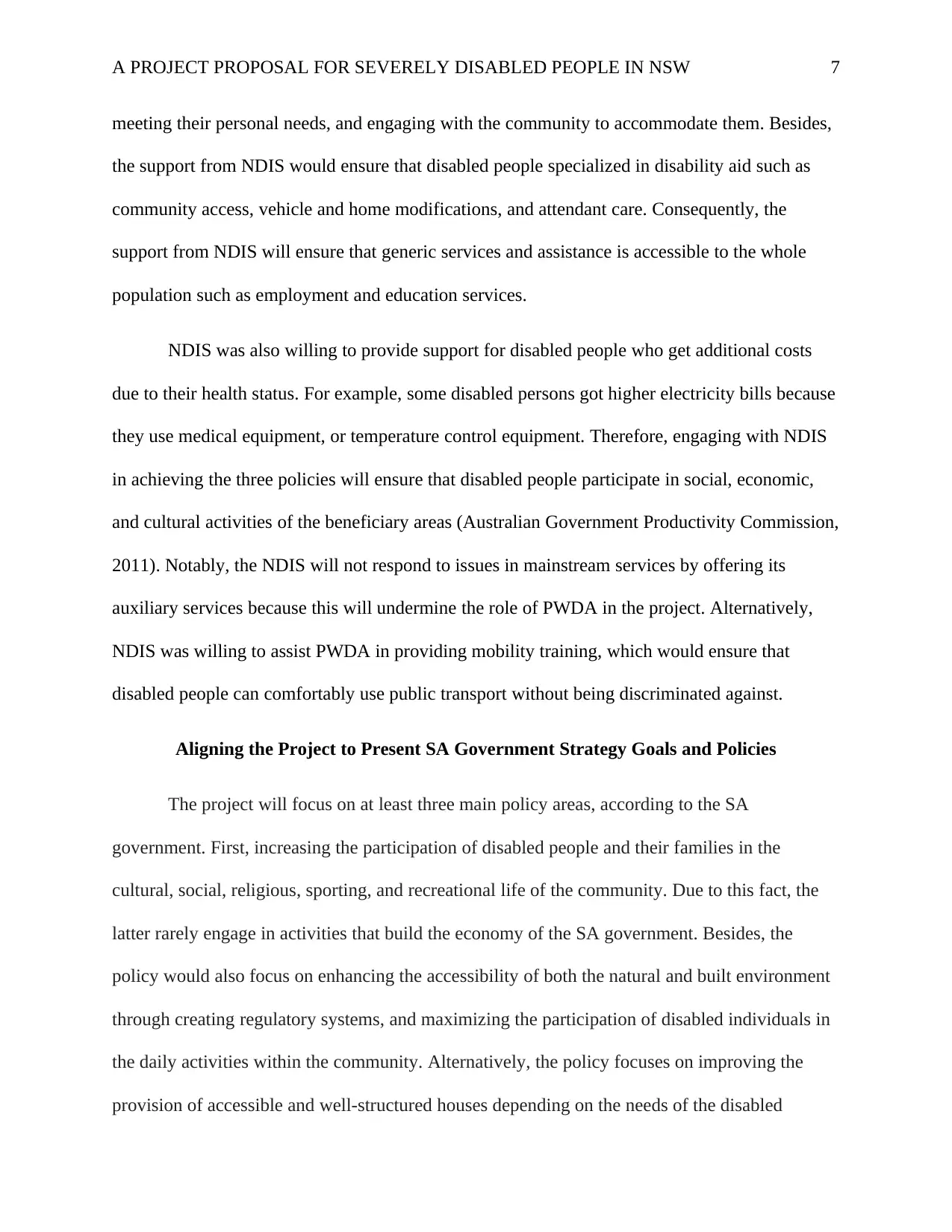
A PROJECT PROPOSAL FOR SEVERELY DISABLED PEOPLE IN NSW 7
meeting their personal needs, and engaging with the community to accommodate them. Besides,
the support from NDIS would ensure that disabled people specialized in disability aid such as
community access, vehicle and home modifications, and attendant care. Consequently, the
support from NDIS will ensure that generic services and assistance is accessible to the whole
population such as employment and education services.
NDIS was also willing to provide support for disabled people who get additional costs
due to their health status. For example, some disabled persons got higher electricity bills because
they use medical equipment, or temperature control equipment. Therefore, engaging with NDIS
in achieving the three policies will ensure that disabled people participate in social, economic,
and cultural activities of the beneficiary areas (Australian Government Productivity Commission,
2011). Notably, the NDIS will not respond to issues in mainstream services by offering its
auxiliary services because this will undermine the role of PWDA in the project. Alternatively,
NDIS was willing to assist PWDA in providing mobility training, which would ensure that
disabled people can comfortably use public transport without being discriminated against.
Aligning the Project to Present SA Government Strategy Goals and Policies
The project will focus on at least three main policy areas, according to the SA
government. First, increasing the participation of disabled people and their families in the
cultural, social, religious, sporting, and recreational life of the community. Due to this fact, the
latter rarely engage in activities that build the economy of the SA government. Besides, the
policy would also focus on enhancing the accessibility of both the natural and built environment
through creating regulatory systems, and maximizing the participation of disabled individuals in
the daily activities within the community. Alternatively, the policy focuses on improving the
provision of accessible and well-structured houses depending on the needs of the disabled
meeting their personal needs, and engaging with the community to accommodate them. Besides,
the support from NDIS would ensure that disabled people specialized in disability aid such as
community access, vehicle and home modifications, and attendant care. Consequently, the
support from NDIS will ensure that generic services and assistance is accessible to the whole
population such as employment and education services.
NDIS was also willing to provide support for disabled people who get additional costs
due to their health status. For example, some disabled persons got higher electricity bills because
they use medical equipment, or temperature control equipment. Therefore, engaging with NDIS
in achieving the three policies will ensure that disabled people participate in social, economic,
and cultural activities of the beneficiary areas (Australian Government Productivity Commission,
2011). Notably, the NDIS will not respond to issues in mainstream services by offering its
auxiliary services because this will undermine the role of PWDA in the project. Alternatively,
NDIS was willing to assist PWDA in providing mobility training, which would ensure that
disabled people can comfortably use public transport without being discriminated against.
Aligning the Project to Present SA Government Strategy Goals and Policies
The project will focus on at least three main policy areas, according to the SA
government. First, increasing the participation of disabled people and their families in the
cultural, social, religious, sporting, and recreational life of the community. Due to this fact, the
latter rarely engage in activities that build the economy of the SA government. Besides, the
policy would also focus on enhancing the accessibility of both the natural and built environment
through creating regulatory systems, and maximizing the participation of disabled individuals in
the daily activities within the community. Alternatively, the policy focuses on improving the
provision of accessible and well-structured houses depending on the needs of the disabled
Paraphrase This Document
Need a fresh take? Get an instant paraphrase of this document with our AI Paraphraser
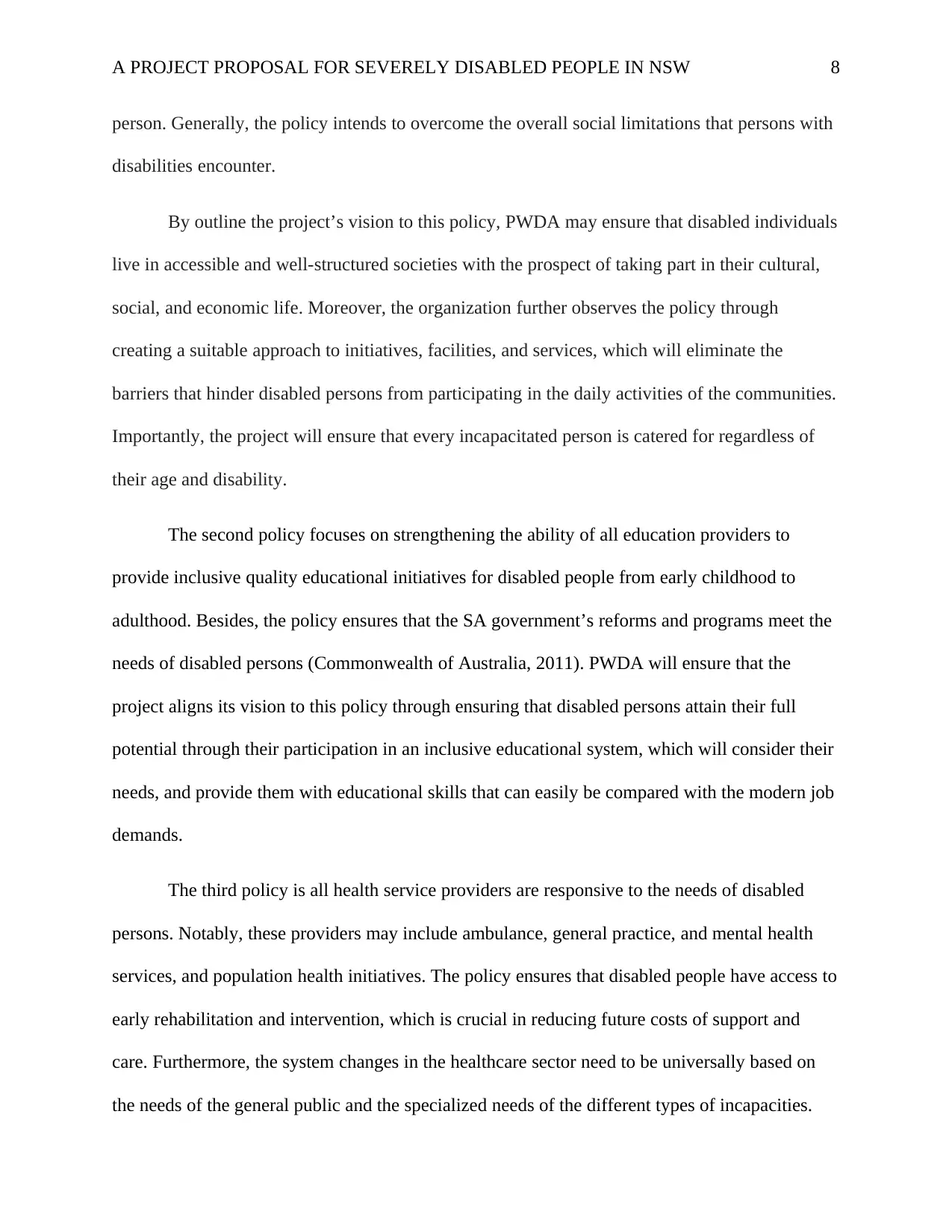
A PROJECT PROPOSAL FOR SEVERELY DISABLED PEOPLE IN NSW 8
person. Generally, the policy intends to overcome the overall social limitations that persons with
disabilities encounter.
By outline the project’s vision to this policy, PWDA may ensure that disabled individuals
live in accessible and well-structured societies with the prospect of taking part in their cultural,
social, and economic life. Moreover, the organization further observes the policy through
creating a suitable approach to initiatives, facilities, and services, which will eliminate the
barriers that hinder disabled persons from participating in the daily activities of the communities.
Importantly, the project will ensure that every incapacitated person is catered for regardless of
their age and disability.
The second policy focuses on strengthening the ability of all education providers to
provide inclusive quality educational initiatives for disabled people from early childhood to
adulthood. Besides, the policy ensures that the SA government’s reforms and programs meet the
needs of disabled persons (Commonwealth of Australia, 2011). PWDA will ensure that the
project aligns its vision to this policy through ensuring that disabled persons attain their full
potential through their participation in an inclusive educational system, which will consider their
needs, and provide them with educational skills that can easily be compared with the modern job
demands.
The third policy is all health service providers are responsive to the needs of disabled
persons. Notably, these providers may include ambulance, general practice, and mental health
services, and population health initiatives. The policy ensures that disabled people have access to
early rehabilitation and intervention, which is crucial in reducing future costs of support and
care. Furthermore, the system changes in the healthcare sector need to be universally based on
the needs of the general public and the specialized needs of the different types of incapacities.
person. Generally, the policy intends to overcome the overall social limitations that persons with
disabilities encounter.
By outline the project’s vision to this policy, PWDA may ensure that disabled individuals
live in accessible and well-structured societies with the prospect of taking part in their cultural,
social, and economic life. Moreover, the organization further observes the policy through
creating a suitable approach to initiatives, facilities, and services, which will eliminate the
barriers that hinder disabled persons from participating in the daily activities of the communities.
Importantly, the project will ensure that every incapacitated person is catered for regardless of
their age and disability.
The second policy focuses on strengthening the ability of all education providers to
provide inclusive quality educational initiatives for disabled people from early childhood to
adulthood. Besides, the policy ensures that the SA government’s reforms and programs meet the
needs of disabled persons (Commonwealth of Australia, 2011). PWDA will ensure that the
project aligns its vision to this policy through ensuring that disabled persons attain their full
potential through their participation in an inclusive educational system, which will consider their
needs, and provide them with educational skills that can easily be compared with the modern job
demands.
The third policy is all health service providers are responsive to the needs of disabled
persons. Notably, these providers may include ambulance, general practice, and mental health
services, and population health initiatives. The policy ensures that disabled people have access to
early rehabilitation and intervention, which is crucial in reducing future costs of support and
care. Furthermore, the system changes in the healthcare sector need to be universally based on
the needs of the general public and the specialized needs of the different types of incapacities.
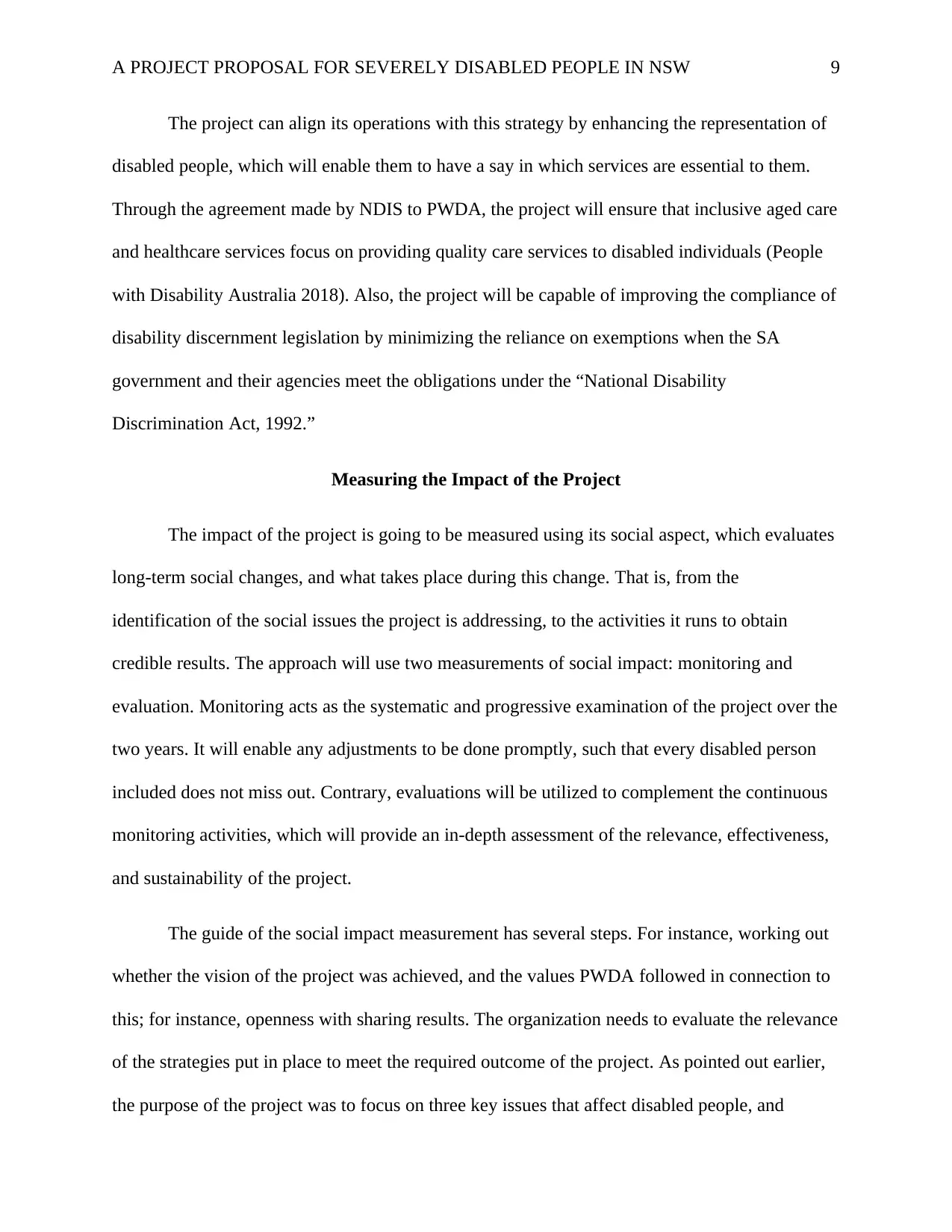
A PROJECT PROPOSAL FOR SEVERELY DISABLED PEOPLE IN NSW 9
The project can align its operations with this strategy by enhancing the representation of
disabled people, which will enable them to have a say in which services are essential to them.
Through the agreement made by NDIS to PWDA, the project will ensure that inclusive aged care
and healthcare services focus on providing quality care services to disabled individuals (People
with Disability Australia 2018). Also, the project will be capable of improving the compliance of
disability discernment legislation by minimizing the reliance on exemptions when the SA
government and their agencies meet the obligations under the “National Disability
Discrimination Act, 1992.”
Measuring the Impact of the Project
The impact of the project is going to be measured using its social aspect, which evaluates
long-term social changes, and what takes place during this change. That is, from the
identification of the social issues the project is addressing, to the activities it runs to obtain
credible results. The approach will use two measurements of social impact: monitoring and
evaluation. Monitoring acts as the systematic and progressive examination of the project over the
two years. It will enable any adjustments to be done promptly, such that every disabled person
included does not miss out. Contrary, evaluations will be utilized to complement the continuous
monitoring activities, which will provide an in-depth assessment of the relevance, effectiveness,
and sustainability of the project.
The guide of the social impact measurement has several steps. For instance, working out
whether the vision of the project was achieved, and the values PWDA followed in connection to
this; for instance, openness with sharing results. The organization needs to evaluate the relevance
of the strategies put in place to meet the required outcome of the project. As pointed out earlier,
the purpose of the project was to focus on three key issues that affect disabled people, and
The project can align its operations with this strategy by enhancing the representation of
disabled people, which will enable them to have a say in which services are essential to them.
Through the agreement made by NDIS to PWDA, the project will ensure that inclusive aged care
and healthcare services focus on providing quality care services to disabled individuals (People
with Disability Australia 2018). Also, the project will be capable of improving the compliance of
disability discernment legislation by minimizing the reliance on exemptions when the SA
government and their agencies meet the obligations under the “National Disability
Discrimination Act, 1992.”
Measuring the Impact of the Project
The impact of the project is going to be measured using its social aspect, which evaluates
long-term social changes, and what takes place during this change. That is, from the
identification of the social issues the project is addressing, to the activities it runs to obtain
credible results. The approach will use two measurements of social impact: monitoring and
evaluation. Monitoring acts as the systematic and progressive examination of the project over the
two years. It will enable any adjustments to be done promptly, such that every disabled person
included does not miss out. Contrary, evaluations will be utilized to complement the continuous
monitoring activities, which will provide an in-depth assessment of the relevance, effectiveness,
and sustainability of the project.
The guide of the social impact measurement has several steps. For instance, working out
whether the vision of the project was achieved, and the values PWDA followed in connection to
this; for instance, openness with sharing results. The organization needs to evaluate the relevance
of the strategies put in place to meet the required outcome of the project. As pointed out earlier,
the purpose of the project was to focus on three key issues that affect disabled people, and
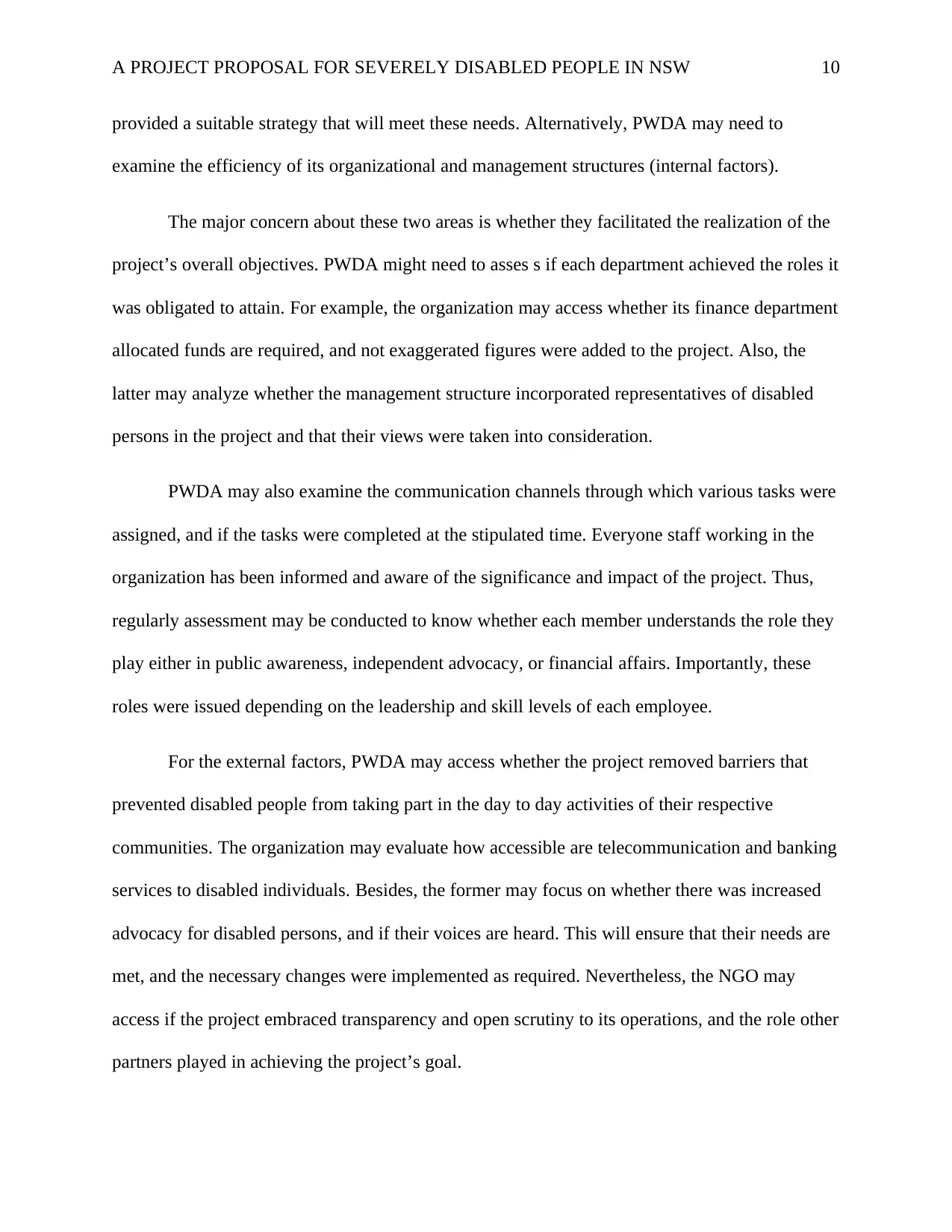
A PROJECT PROPOSAL FOR SEVERELY DISABLED PEOPLE IN NSW 10
provided a suitable strategy that will meet these needs. Alternatively, PWDA may need to
examine the efficiency of its organizational and management structures (internal factors).
The major concern about these two areas is whether they facilitated the realization of the
project’s overall objectives. PWDA might need to asses s if each department achieved the roles it
was obligated to attain. For example, the organization may access whether its finance department
allocated funds are required, and not exaggerated figures were added to the project. Also, the
latter may analyze whether the management structure incorporated representatives of disabled
persons in the project and that their views were taken into consideration.
PWDA may also examine the communication channels through which various tasks were
assigned, and if the tasks were completed at the stipulated time. Everyone staff working in the
organization has been informed and aware of the significance and impact of the project. Thus,
regularly assessment may be conducted to know whether each member understands the role they
play either in public awareness, independent advocacy, or financial affairs. Importantly, these
roles were issued depending on the leadership and skill levels of each employee.
For the external factors, PWDA may access whether the project removed barriers that
prevented disabled people from taking part in the day to day activities of their respective
communities. The organization may evaluate how accessible are telecommunication and banking
services to disabled individuals. Besides, the former may focus on whether there was increased
advocacy for disabled persons, and if their voices are heard. This will ensure that their needs are
met, and the necessary changes were implemented as required. Nevertheless, the NGO may
access if the project embraced transparency and open scrutiny to its operations, and the role other
partners played in achieving the project’s goal.
provided a suitable strategy that will meet these needs. Alternatively, PWDA may need to
examine the efficiency of its organizational and management structures (internal factors).
The major concern about these two areas is whether they facilitated the realization of the
project’s overall objectives. PWDA might need to asses s if each department achieved the roles it
was obligated to attain. For example, the organization may access whether its finance department
allocated funds are required, and not exaggerated figures were added to the project. Also, the
latter may analyze whether the management structure incorporated representatives of disabled
persons in the project and that their views were taken into consideration.
PWDA may also examine the communication channels through which various tasks were
assigned, and if the tasks were completed at the stipulated time. Everyone staff working in the
organization has been informed and aware of the significance and impact of the project. Thus,
regularly assessment may be conducted to know whether each member understands the role they
play either in public awareness, independent advocacy, or financial affairs. Importantly, these
roles were issued depending on the leadership and skill levels of each employee.
For the external factors, PWDA may access whether the project removed barriers that
prevented disabled people from taking part in the day to day activities of their respective
communities. The organization may evaluate how accessible are telecommunication and banking
services to disabled individuals. Besides, the former may focus on whether there was increased
advocacy for disabled persons, and if their voices are heard. This will ensure that their needs are
met, and the necessary changes were implemented as required. Nevertheless, the NGO may
access if the project embraced transparency and open scrutiny to its operations, and the role other
partners played in achieving the project’s goal.
Secure Best Marks with AI Grader
Need help grading? Try our AI Grader for instant feedback on your assignments.
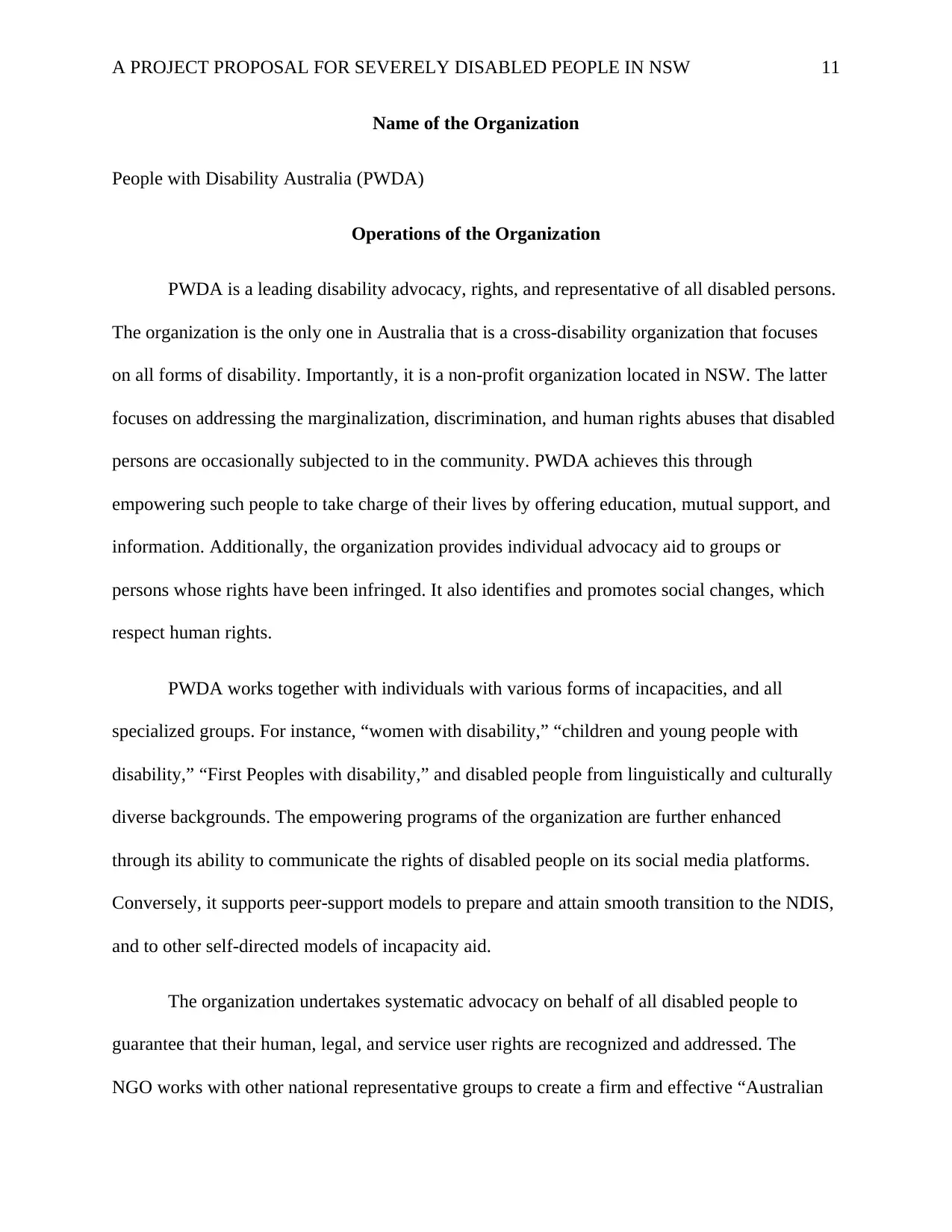
A PROJECT PROPOSAL FOR SEVERELY DISABLED PEOPLE IN NSW 11
Name of the Organization
People with Disability Australia (PWDA)
Operations of the Organization
PWDA is a leading disability advocacy, rights, and representative of all disabled persons.
The organization is the only one in Australia that is a cross-disability organization that focuses
on all forms of disability. Importantly, it is a non-profit organization located in NSW. The latter
focuses on addressing the marginalization, discrimination, and human rights abuses that disabled
persons are occasionally subjected to in the community. PWDA achieves this through
empowering such people to take charge of their lives by offering education, mutual support, and
information. Additionally, the organization provides individual advocacy aid to groups or
persons whose rights have been infringed. It also identifies and promotes social changes, which
respect human rights.
PWDA works together with individuals with various forms of incapacities, and all
specialized groups. For instance, “women with disability,” “children and young people with
disability,” “First Peoples with disability,” and disabled people from linguistically and culturally
diverse backgrounds. The empowering programs of the organization are further enhanced
through its ability to communicate the rights of disabled people on its social media platforms.
Conversely, it supports peer-support models to prepare and attain smooth transition to the NDIS,
and to other self-directed models of incapacity aid.
The organization undertakes systematic advocacy on behalf of all disabled people to
guarantee that their human, legal, and service user rights are recognized and addressed. The
NGO works with other national representative groups to create a firm and effective “Australian
Name of the Organization
People with Disability Australia (PWDA)
Operations of the Organization
PWDA is a leading disability advocacy, rights, and representative of all disabled persons.
The organization is the only one in Australia that is a cross-disability organization that focuses
on all forms of disability. Importantly, it is a non-profit organization located in NSW. The latter
focuses on addressing the marginalization, discrimination, and human rights abuses that disabled
persons are occasionally subjected to in the community. PWDA achieves this through
empowering such people to take charge of their lives by offering education, mutual support, and
information. Additionally, the organization provides individual advocacy aid to groups or
persons whose rights have been infringed. It also identifies and promotes social changes, which
respect human rights.
PWDA works together with individuals with various forms of incapacities, and all
specialized groups. For instance, “women with disability,” “children and young people with
disability,” “First Peoples with disability,” and disabled people from linguistically and culturally
diverse backgrounds. The empowering programs of the organization are further enhanced
through its ability to communicate the rights of disabled people on its social media platforms.
Conversely, it supports peer-support models to prepare and attain smooth transition to the NDIS,
and to other self-directed models of incapacity aid.
The organization undertakes systematic advocacy on behalf of all disabled people to
guarantee that their human, legal, and service user rights are recognized and addressed. The
NGO works with other national representative groups to create a firm and effective “Australian

A PROJECT PROPOSAL FOR SEVERELY DISABLED PEOPLE IN NSW 12
Cross Disability Alliance,” which will make sure that the concerns, rights, and needs of every
disabled Australian are represented in the Australian government (People with Disability, 2015).
Also, PWDA guarantees that all the services it provides to its constituency and clients are of high
quality and continuously improve. Based on this fact, the organization is well-governed with an
effective management structure.
Location of the Project
The project prioritizes mainly on disabled people in NSW who have severe limitations as
it affects their mobility and access to care services. As identified earlier, at least six percent of its
population have serious physical limitations. Notably, the project will focus on NSW regions
with the highest rates of disability cases. These are South Eastern, Central West, and Hunter. For
85 percent of disabled people in these regions, physical situations influenced their disability
(Australian Bureau of Statistics, n.d.). For 15 percent of the latter, behavioral and mental
disorders were the cause of their incapacities.
The Budget of the Project
$ 72,675.60
Cross Disability Alliance,” which will make sure that the concerns, rights, and needs of every
disabled Australian are represented in the Australian government (People with Disability, 2015).
Also, PWDA guarantees that all the services it provides to its constituency and clients are of high
quality and continuously improve. Based on this fact, the organization is well-governed with an
effective management structure.
Location of the Project
The project prioritizes mainly on disabled people in NSW who have severe limitations as
it affects their mobility and access to care services. As identified earlier, at least six percent of its
population have serious physical limitations. Notably, the project will focus on NSW regions
with the highest rates of disability cases. These are South Eastern, Central West, and Hunter. For
85 percent of disabled people in these regions, physical situations influenced their disability
(Australian Bureau of Statistics, n.d.). For 15 percent of the latter, behavioral and mental
disorders were the cause of their incapacities.
The Budget of the Project
$ 72,675.60
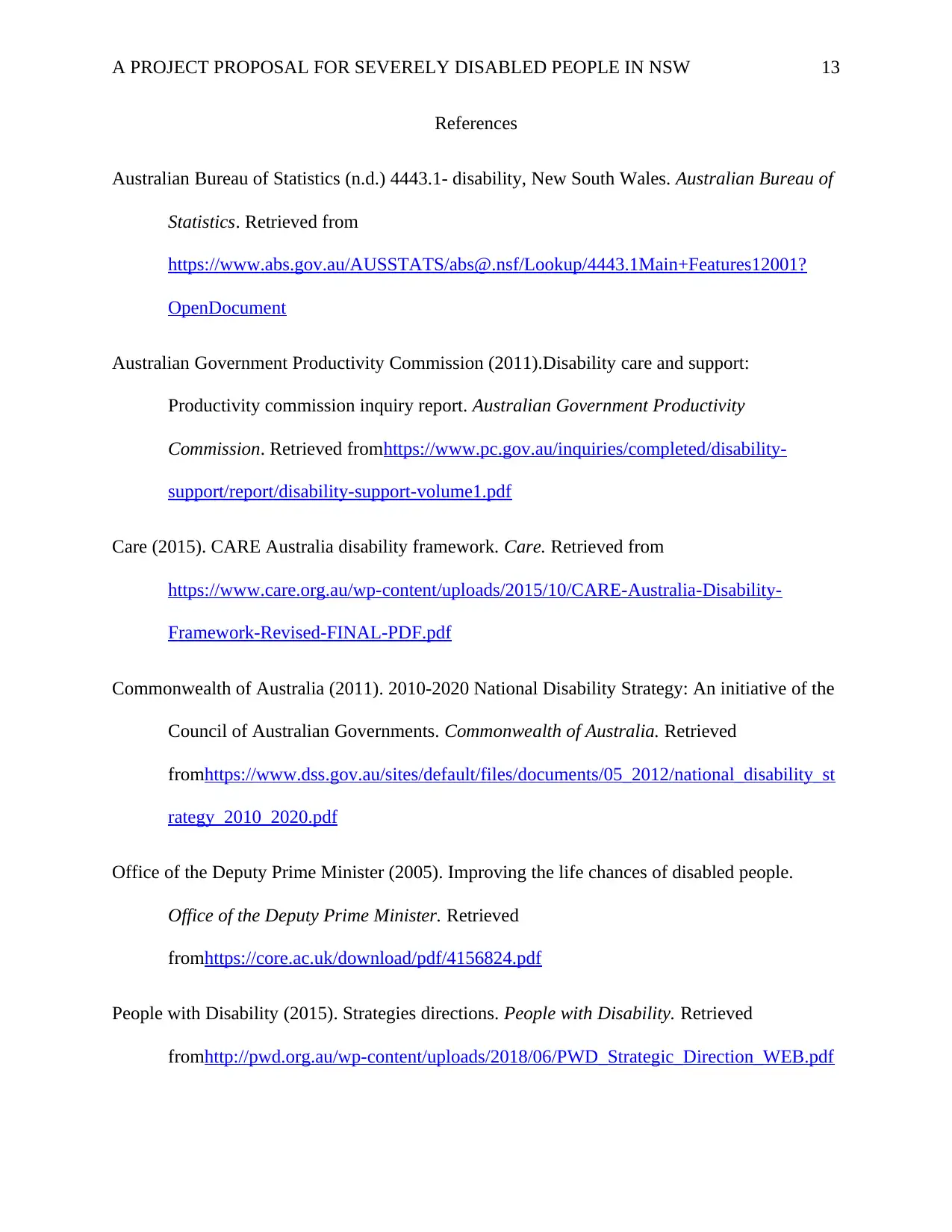
A PROJECT PROPOSAL FOR SEVERELY DISABLED PEOPLE IN NSW 13
References
Australian Bureau of Statistics (n.d.) 4443.1- disability, New South Wales. Australian Bureau of
Statistics. Retrieved from
https://www.abs.gov.au/AUSSTATS/abs@.nsf/Lookup/4443.1Main+Features12001?
OpenDocument
Australian Government Productivity Commission (2011).Disability care and support:
Productivity commission inquiry report. Australian Government Productivity
Commission. Retrieved fromhttps://www.pc.gov.au/inquiries/completed/disability-
support/report/disability-support-volume1.pdf
Care (2015). CARE Australia disability framework. Care. Retrieved from
https://www.care.org.au/wp-content/uploads/2015/10/CARE-Australia-Disability-
Framework-Revised-FINAL-PDF.pdf
Commonwealth of Australia (2011). 2010-2020 National Disability Strategy: An initiative of the
Council of Australian Governments. Commonwealth of Australia. Retrieved
fromhttps://www.dss.gov.au/sites/default/files/documents/05_2012/national_disability_st
rategy_2010_2020.pdf
Office of the Deputy Prime Minister (2005). Improving the life chances of disabled people.
Office of the Deputy Prime Minister. Retrieved
fromhttps://core.ac.uk/download/pdf/4156824.pdf
People with Disability (2015). Strategies directions. People with Disability. Retrieved
fromhttp://pwd.org.au/wp-content/uploads/2018/06/PWD_Strategic_Direction_WEB.pdf
References
Australian Bureau of Statistics (n.d.) 4443.1- disability, New South Wales. Australian Bureau of
Statistics. Retrieved from
https://www.abs.gov.au/AUSSTATS/abs@.nsf/Lookup/4443.1Main+Features12001?
OpenDocument
Australian Government Productivity Commission (2011).Disability care and support:
Productivity commission inquiry report. Australian Government Productivity
Commission. Retrieved fromhttps://www.pc.gov.au/inquiries/completed/disability-
support/report/disability-support-volume1.pdf
Care (2015). CARE Australia disability framework. Care. Retrieved from
https://www.care.org.au/wp-content/uploads/2015/10/CARE-Australia-Disability-
Framework-Revised-FINAL-PDF.pdf
Commonwealth of Australia (2011). 2010-2020 National Disability Strategy: An initiative of the
Council of Australian Governments. Commonwealth of Australia. Retrieved
fromhttps://www.dss.gov.au/sites/default/files/documents/05_2012/national_disability_st
rategy_2010_2020.pdf
Office of the Deputy Prime Minister (2005). Improving the life chances of disabled people.
Office of the Deputy Prime Minister. Retrieved
fromhttps://core.ac.uk/download/pdf/4156824.pdf
People with Disability (2015). Strategies directions. People with Disability. Retrieved
fromhttp://pwd.org.au/wp-content/uploads/2018/06/PWD_Strategic_Direction_WEB.pdf
Paraphrase This Document
Need a fresh take? Get an instant paraphrase of this document with our AI Paraphraser
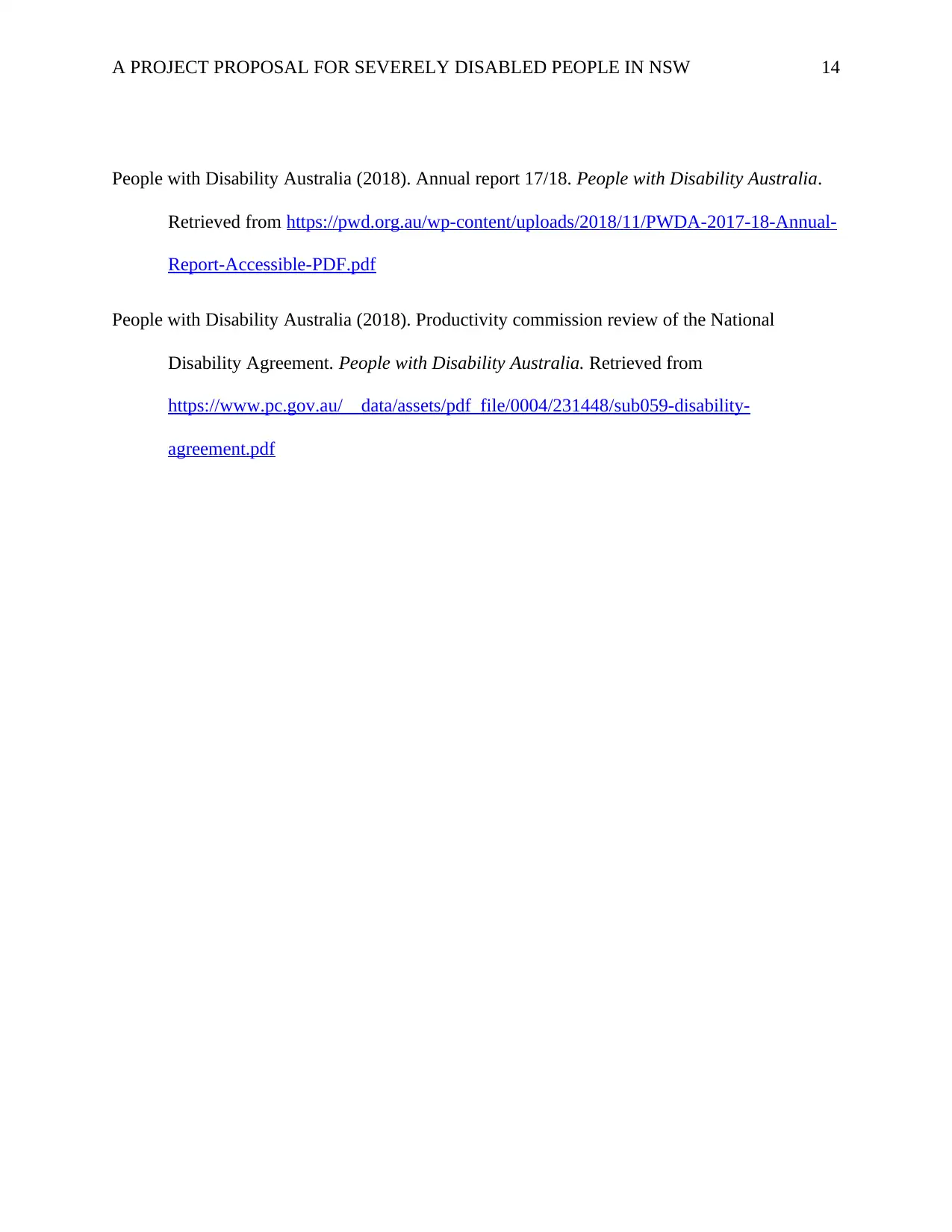
A PROJECT PROPOSAL FOR SEVERELY DISABLED PEOPLE IN NSW 14
People with Disability Australia (2018). Annual report 17/18. People with Disability Australia.
Retrieved from https://pwd.org.au/wp-content/uploads/2018/11/PWDA-2017-18-Annual-
Report-Accessible-PDF.pdf
People with Disability Australia (2018). Productivity commission review of the National
Disability Agreement. People with Disability Australia. Retrieved from
https://www.pc.gov.au/__data/assets/pdf_file/0004/231448/sub059-disability-
agreement.pdf
People with Disability Australia (2018). Annual report 17/18. People with Disability Australia.
Retrieved from https://pwd.org.au/wp-content/uploads/2018/11/PWDA-2017-18-Annual-
Report-Accessible-PDF.pdf
People with Disability Australia (2018). Productivity commission review of the National
Disability Agreement. People with Disability Australia. Retrieved from
https://www.pc.gov.au/__data/assets/pdf_file/0004/231448/sub059-disability-
agreement.pdf
1 out of 14
Your All-in-One AI-Powered Toolkit for Academic Success.
+13062052269
info@desklib.com
Available 24*7 on WhatsApp / Email
![[object Object]](/_next/static/media/star-bottom.7253800d.svg)
Unlock your academic potential
© 2024 | Zucol Services PVT LTD | All rights reserved.